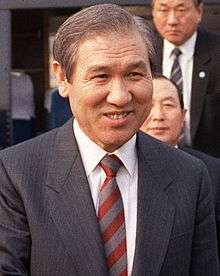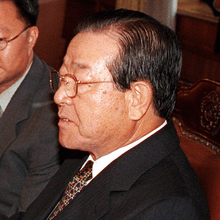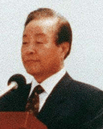South Korean presidential election, 1987
| | |||||||||||||||||||||||||||||||||||||||||||
| |||||||||||||||||||||||||||||||||||||||||||
| |||||||||||||||||||||||||||||||||||||||||||
|
| |||||||||||||||||||||||||||||||||||||||||||
| provinces and cities majority won by ■ – Roh Tae-woo
■ – Kim Young-sam | |||||||||||||||||||||||||||||||||||||||||||
| |||||||||||||||||||||||||||||||||||||||||||
Presidential elections were held in South Korea on 16 December 1987.[1]
It was the first free direct presidential election held in South Korea, which marked the beginning of the Sixth Republic. The result was a victory for Roh Tae-woo, who won 35.9% of the vote. Voter turnout was 89.2%.
Results
| Candidate | Party | Votes | % | |
|---|---|---|---|---|
| Roh Tae-woo | Democratic Justice Party | 8,282,738 | 36.6 | |
| Kim Young-sam | Reunification Democratic Party | 6,337,581 | 28.0 | |
| Kim Dae-jung | Party for Peace and Democracy | 6,113,375 | 27.0 | |
| Kim Jong-pil | New Democratic Republican Party | 1,823,067 | 8.1 | |
| Shin Jeong-yil | Unified Korea Party | 46,650 | 0.2 | |
| Total (Turnout: 89.2%) | 23,066,419 | 100.0 | ||
| Source: Nohlen et al | ||||
By province
| provinces · cities |  |
 |
.jpg) |
 | ||||
|---|---|---|---|---|---|---|---|---|
| Roh Tae-woo DJP |
Kim Young-sam RDP |
Kim Dae-jung PPD |
Kim Jong-pil NDRP | |||||
| Votes | % | Votes | % | Votes | % | Votes | % | |
| Seoul | 1,682,824 | 30.3% | 1,637,347 | 29.1% | 1,833,010 | 32.6% | 460,988 | 8.2% |
| Busan | 640,622 | 32.1% | 1,117,011 | 56.0% | 182,409 | 9.1% | 51,663 | 2.6% |
| Daegu | 800,363 | 70.7% | 274,880 | 24.3% | 29,831 | 2.6% | 23,230 | 2.1% |
| Incheon | 326,186 | 39.4% | 248,604 | 30.0% | 176,611 | 21.3% | 76,333 | 9.2% |
| Gwangju | 22,943 | 4.8% | 2,471 | 0.5% | 449,554 | 94.4% | 1,111 | 0.2% |
| Gyeonggi | 1,204,235 | 41.4% | 800,274 | 27.5% | 647,934 | 22.3% | 247,259 | 8.5% |
| Gangwon | 456,596 | 59.3% | 240,585 | 26.1% | 81,478 | 8.8% | 49,954 | 5.4% |
| Chungcheongbuk | 355,222 | 46.9% | 213,851 | 28.2% | 83,132 | 11.0% | 102,456 | 13.5% |
| Chungcheongnam | 402,491 | 26.2% | 246,527 | 16.1% | 190,772 | 12.4% | 691,214 | 45.0% |
| Jeollabuk | 160,760 | 14.1% | 17,130 | 1.5% | 948,955 | 83.5% | 8,629 | 0.8% |
| Jeollanam | 119,229 | 8.2% | 16,826 | 1.2% | 1,317,990 | 90.3% | 4,831 | 0.3% |
| Gyeongsangbuk | 1,108,035 | 66.4% | 470,189 | 28.2% | 39,756 | 2.4% | 43,227 | 2.6% |
| Gyeongsangnam | 792,757 | 41.2% | 987,042 | 51.3% | 86,804 | 4.5% | 51,242 | 2.7% |
| Jeju | 120,502 | 49.8% | 64,844 | 26.8% | 45,139 | 18.6% | 10,930 | 4.5% |
References
- ↑ Dieter Nohlen, Florian Grotz & Christof Hartmann (2001) Elections in Asia: A data handbook, Volume II, p420 ISBN 0-19-924959-8
This article is issued from Wikipedia - version of the 2/28/2016. The text is available under the Creative Commons Attribution/Share Alike but additional terms may apply for the media files.

.png)

